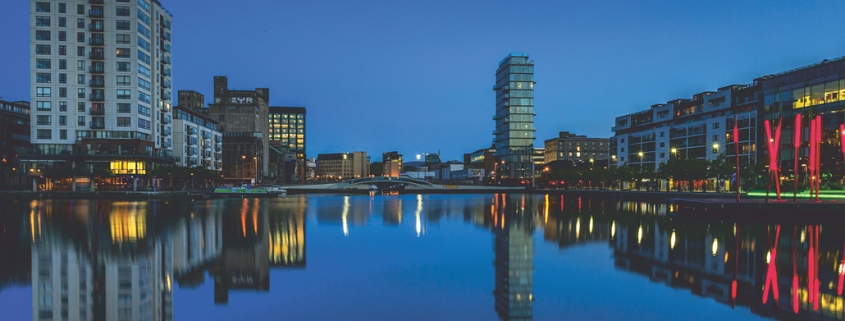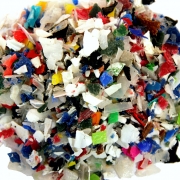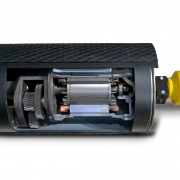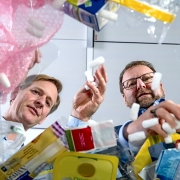Ireland: Investments in a Developed Waste Infrastructure Are Worth it
For Kieran Mullins, Chairman of the Irish Waste Management Association (IWMA), Ireland has shown a fantastic performance. “Twenty years ago, just 7.8 percent of municipal waste was recycled or recovered, but a commitment by Ireland’s householders to recycling and greater environmental awareness means we have made huge gains since then. Everyone in Ireland should be very proud of these achievements”.
According to Eurostat in 2013, Ireland was the joint third for recycling within the EU by recovering and diverting 58 percent of all municipal waste generated by Irish consumers from landfill. The IWMA even estimated an 80 percent recovery rate based on an estimate of 2.5 million tons of municipal waste managed each year in Ireland and industry knowledge that currently approximately 500,000 tons per annum of this waste is sent to landfill for disposal. The remaining about two million tons were recovered, including recycling, composting, use as a fuel in cement kilns and waste to energy incineration in Ireland and abroad.
Paper accounted for the largest volume
Repak is a not-for-profit company set up by Irish business, owned by its members and operating as a compliance scheme for packaging recovery. According to its annual report in 2016, the company funded the recovery and recycling of 794,848 tons of household and backdoor packaging waste. A total of 593,991 tons of packaging waste was sent for recycling, and a total of 200,857 tons was sent for recovery; this includes solid recovered waste (SRF), refuse derived fuel (RDF) and fuel for wood pellet/chip for boiler fuel. Paper accounted for the largest volume of tons recycled (49.7 percent), followed by glass (22.2 percent) and plastic (14.3 percent). The total amount increased by four percent in 2015. This growth could be detected in the waste to energy recovery of packaging material (by ten percent) and total tons recycled (by two percent). The Irish Environment Protection Agency proposed figures that, by 2016, recycling (principally of paper and cardboard waste which cannot be reused) would divert 875,371 tons (38.6 percent) from landfill with biological treatment (mainly food and garden waste) contributing 442,129 tons (19.5 percent) to the overall target. Thermal treatment would divert 499,762 tons (22 percent) of residual waste from landfill by the same date. It also established a longer-term target of 80 percent diversion of biodegradable waste from landfill.
Waste-to-energy growing
The amount of waste landfilled was significantly reduced during the last two decades: It diminished from 80 percent in 2001 to 53 percent in 2011. The number of 126 official dumps accepting municipal waste went down to no more than a handful. But not before 2011, the first commercial municipal waste incinerator was put into operation with a capacity of 200,000 tons per year adding to the 300,000 tons annual capacity represented by cement kilns using waste-derived fuels in co-combustion; 20,000 households were then provided with waste-powered electricity. Two further licenses for municipal incinerators were granted at Ringaskiddy and Poolbeg of which the planning permission for the Ringaskiddy incinerator was subsequently rejected.
Once fully operational, the Poolbeg plant in Ireland’s capital Dublin will generate 58 MWh of electricity for export to the national grid every year – equivalent to the amount of electricity used in 80,000 Irish homes. The plant – a public-private partnership – is also capable of producing district heating for up to 50,000 homes. The facility will process 600,000 tons of waste per year and thus offset the need to import 250,000 tons of fossil fuels each year.
Great amount exported
“The most significant change in residual waste treatment has been the shift from disposal to landfill to energy recovery, with six active landfills in 2016, in comparison with 18 in 2012”, balanced the Irish Environmental Protection Agency. In addition to the two incineration plants, three cement kilns are accepting solid recovered fuel (SRF) for co-incineration as an alternative to fossil fuels. According to EPA figures in 2016, the annual incineration capacities include 230,000 tons active, 600,000 tons (the Poolbeg plant) under construction and 343,000 tons by co-incineration at cement kilns. (In later 2018, investment of about 14.5 million Euro is planned into a plastic film waste recycling plant for the procession of 10,000-15,000 tons.) The annual capacity of municipal waste landfill was 910,000 tons built.
But a great amount of residual waste was exported – in the period between 2010 and 2014 with a 10-fold increase. For “thermal waste recovery”, Ireland imported up to 45,000 tons of residual waste for use as fuel in 2015 but exported about 550,000 tons for the same purpose at that time. Ireland – the top producer of plastic waste in Europe – temporarily shipped nearly 95 percent of its plastic waste to China. Regarding the current Chinese import ban, Séamus Clancy, chief executive of Repak, recapitulated that “until now, we have been too reliant on China and the Far East for recycling facilities, particularly for plastics, but also for paper”.
Some waste infrastructure deficits
The aforementioned EPA paper had already warned in 2016 that if Ireland is largely dependent on its export market and has insufficiently developed national capacity, the country becomes “vulnerable to external forces such as economic recession, currency fluctuations and any changes to import policy in the EU”. And the European Environment Agency noted “that the vast majority of dry recyclables in Ireland are exported for recovery due to lack of recycling facilities. Thus, continuing to achieve the 50 percent recycling of household waste target in the future is subject to volatile global prices for recyclates.” Consequently, the economic viability of separate waste fraction collection in Ireland would be strongly influenced by these prices.
The EPA paper furthermore discovered “some waste infrastructure deficits”, among them a lack of a hazardous waste landfill – 44 percent of hazardous waste in 2014 was exported, mostly to Great Britain, Germany and Belgium. Other deficits are capacity lacks in recycling. An article supported by the Ministry of Environment has broken down more detailed, what had already been reached and what has to be done: In 2017, Ireland has met the targets for Packaging and Packaging Waste Directive, Landfill Directive, Waste Electrical and Electronic Equipment (WEEE) Directive and Waste Framework Directive. But it had to be registered that there is a risk of missing targets for the end-of-life vehicles, WEEE recast and batteries as well as accumulators.
Existing capacities are unbalanced
Already in 2014, Engineers Ireland had published a review of infrastructure that urged investment in collection and treatment infrastructure, among others composting facilities and anaerobic digestion plants. “Investment in infrastructure is needed if we are to close the capacity gap and become more self-reliant in terms of treating our own waste. The State’s existing capacities are unbalanced with high capacity levels of pre-treatment and mechanical treatment and below capacity levels of final destination facilities, e.g., biological treatment plants and waste-to-energy plants.” The review requested for programs and projects “continued investment if economic growth and waste arising are to be decoupled in a sustained manner”. And it earmarked a five-years-plan including a “correct mix of waste capacity infrastructure to manage non-hazardous and hazardous wastes”, further development of biological treatment capacities including anaerobic digestion, and the improvement of waste and resource management modules as part of civil and environmental engineering courses.
Needed: a domestic waste management
In November 2017, Indaver Group – Dublin-based waste management business for industry and authorities – pleaded for a coordinated and developed waste infrastructure strategy: not only to support the Irish economy and society but also to become self-sufficient and develop in a sustainable and environmentally sound manner. Complying with the EU Directive requirements would thereby help to avoid the imposition of penalties. Indaver insisted on the need to address a domestic waste management in the National Planning Framework “in terms of an Ireland as seen in an all-island context”. And underlined that the Waste Management Plans for the Southern, Eastern Midlands and Connacht/Ulster Regions and the National Hazardous Waste Management Plan 2014-2020 have called for further investment in treatment infrastructure for waste.
In its 2017 Environmental Implementation Review Country Report, the EU Commission was skeptical whether Ireland would reach the foreseen recycling aims: “Caution is needed so that future investments in incineration (energy recovery) or in mechanical biological treatment (MBT) plants based on mixed waste input do not hinder Ireland from meeting the recycling target for 2020.” However, the report was sure that investment could be worth it: Full implementation of the existing legislation could create more than 6,100 jobs in Ireland and increase the annual turnover of the waste sector by over 640 million Euro.
Photo: pixabay
GR 2/2018








